
We’ve all heard the spooky folktales and seen the eerie depictions of bats in popular culture. But how much do we actually know about these fascinating creatures of the night? Considered conservation indicators and vital for a balanced ecosystem, bet you didn’t know that they’re a key component in our daily lives too. Bats aren’t just about spooky Halloween folklore; they perform essential roles in pollinating flowers, dispersing seeds, and controlling pests which hugely impact agricultural economies. So, in essence, these fluttering nocturnals weave a web of benefits for both the environment and human beings.
Now, before you hurry to your search engine and start looking for more bat-shaped trivia, sit back and leave the hard research to us. We’ve compiled a comprehensive narrative on these captivating Night Avengers, their life, their habitat, and the ecological services they render. In this narrative, we’ll delve deep into the realm of these elusive creatures, zoom in on the myths, misunderstandings, and startling truths about them. This narrative aims to acquaint you with the detailed bat ecology, and the importance of bats that transcends beyond their portrayed mystique.
Through the narrative, we don’t just aim to feed you facts. Instead, we aspire to enlighten readers on the intricate workshop of these furry flyers and how intrinsically their existence is knotted with ours. By the time you reach the end of this narrative, you will have a newfound respect and appreciation for these winged wonders, their gentle nature, and their critical services to our ecosystems. Pull up a seating around the metaphorical fire as we prepare to transport you into the world of bats and their enduring legacy. On that note, let’s shift gears from this introduction and neatly blend into understanding the evolution and diversity of bats. Who knew that the study of bats could be such an exciting journey, much like unboxing a mystery whose layers keep getting interesting?
The Anatomy of Bats: Adaptations for Flight and Echolocation
When it comes to understanding bats, we begin with their unique anatomy designed for two special traits – flight and echolocation. Bats, belonging to the Chiroptera order, are the only mammals gifted with the power of sustained flight thanks to their physiological adaptations.
Bat Physiology for Flight
Bats house long, flexible bones that stretch out to form a wing membrane, effectively enabling them to fly. With over 60% of their skeletal muscle mass allocated in their wings, bats also possess a larger heart proportionally to their body size, facilitating extraordinary endurance during flight.
Differences Between Bat Wings and Bird Wings
Unlike birds, where feathers form the wings, in bats, the structure is primarily a web of skin, aka patagium, encompassing the arm and spanning from their finger bones right down to their tail. This gives bats better maneuverability than birds, with the ability to make sharper turns and slower flights.
Understanding Echolocation
The second defining trait of bats is echolocation, akin to a personal bio sonar system. Echolocation permits bats to navigate and target prey in complete darkness. In the midst of flight, bats emit high-frequency sound waves that bounce off surrounding objects. The returning echoes inform the bats about the location, size, and even texture of the objects – quite a sophisticated acoustic GPS!
Different bat species can distinctively vary in their echolocation frequencies, which contributes to the immense biodiversity. To complement this, bats have evolved to possess acute hearing and olfactory senses, making them some of the supreme nocturnal hunters.
Through understanding bat physiology and their unique adaptations for flight and echolocation, one can appreciate why these creatures have survived and diversified over millions of years. According to Bat Conservation International, there are more than 1,400 identified species of bats, making up about 20% of all known mammal species.
So, the next time you see a bat gracefully flight in your backyard or hear about their impressive echolocation, remember it’s the result of remarkable physiological adaptations that have enabled these creatures to flourish across diverse ecosystems.
Bats are fascinating creatures when looked upon closely, but their role doesn’t end with their flight or their echolocation prowess. As we delve deeper into understanding bats, let’s explore their ecological roles in the subsequent section. Stay tuned!
Bats and the Ecosystem: Ecological Roles
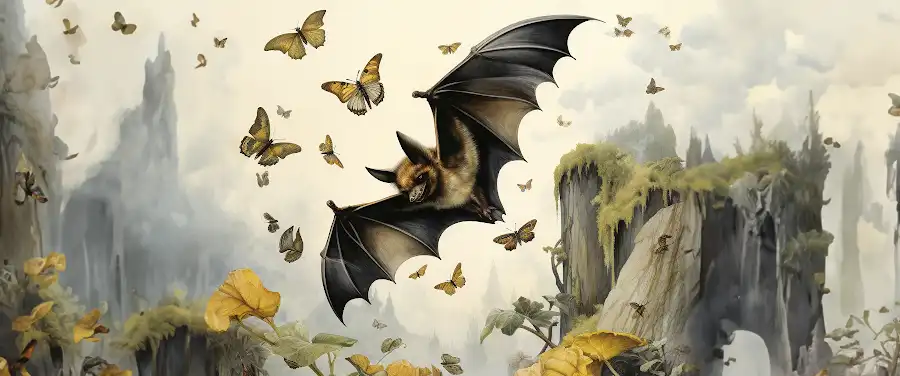
Bats, often encircled by a cloud of mystery and misinterpretation, play vital roles in our ecosystem. Their unique day-to-day activities contribute notably to the healthy functioning of our planet. The roles bats play are broad and fall under important categories such as pollination, seed dispersal, and pest control.
Bats as Pollinators
Believe it or not, bats are essential pollinators in the ecosystem. Their role in pollination is rivaled only by the likes of bees and birds. For example, plants like agave and several species of cacti entirely depend on bats for pollination. This dependence is due to bats’ unique ability to transfer pollen from one plant to another, called bat pollination. Their key interactions help preserve countless plant species and maintain biodiversity.
Bats as Seed Dispersers
In addition to being incredible pollinators, bats are also remarkable seed dispersers. Many tropical plants rely on bats for seed dispersal, which supports the biodiversity of forests and aids in forest regeneration. Through this process, deforested regions can experience new life, further preserving the integrity of our environment.
Here’s an interesting fact – a study showed that “dispersed seeds from fruits eaten by bats grew 50% more successfully than those not consumed by bats.”
Bats and Pest Control
Often overlooked is the bats’ role in pest control. Feeding mostly on insects, a small colony of bats can consume millions of bugs in a single night! This natural pest control mechanism plays a crucial role in maintaining the delicate balance of our ecosystem. It also has substantial economic benefits, helping farmers reduce their dependency on chemical pesticides, thus saving millions of dollars annually.
Their substantial ecological contributions are a clear indication that bats are vital to our planet’s health. Research from the Bat Conservation International sheds light on the fascinating life of bats and their incredible contributions to our ecosystem.
With their ecological roles clearly noted, it’s time to delve into another crucial aspect in understanding bats: their social and behavioral customs.
Those restless flutters and eerie chirps are more than what meets the eye, and it’s upon us to understand their social intricacies to further the cohabitation of humans and bats harmoniously. Stay tuned!
Social and Behavioral Aspects of Bats
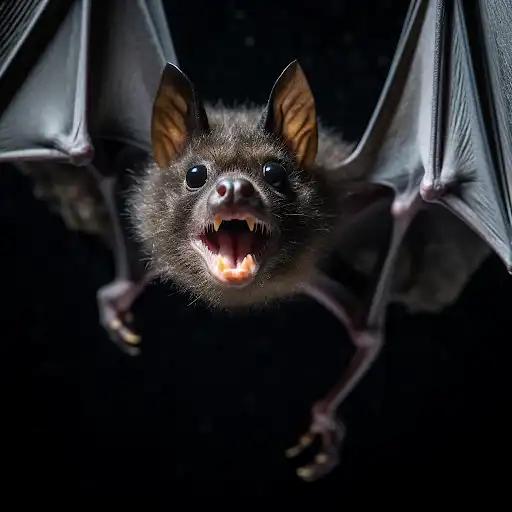
Ever observed the dark canvas of the night adorned with the silhouettes of swooping bats? One might wonder about the complex social structure and unique lifestyle these creatures maintain. From the way they communicate to the migration and hibernation patterns they follow, bats exhibit intriguing behaviors that warrant closer inspection.
Bats’ Social Structure and Behavior
Bats often dwell together in colossal colonies, demonstrating various social structures. Depending on the species, colony sizes can range from a handful of individuals to millions. In many species, females form maternity colonies for breeding purposes, embodying fascinating mating systems and parental care rituals.
Male bats may either live solitarily, form their all-male groups, or cohabitate with the females, showing diversity in the social structures they form. Bats are protective of their offspring, with the mothers taking care of the pups while the males commonly show no involvement in their upbringing.
Communing over long distances, bats utilize unique sound frequencies, a science called echolocation, for navigation and communication. Their assortments of chirps, screeches, and clicks maintain their complex social structure, enhancing their survival in the dark.
Migration and Hibernation in Bats
Like an orchestra changing its tune with the seasons, bats follow patterns of migration and hibernation. As food resources dwindle with the on-set of winter, bats migrate long distances in search of warmer and more bountiful regions.
However, not all bats migrate. Some choose to hibernate, saving energy by reducing their metabolic rate, heart rate, and body temperature during the long winter months. This state of torpor allows them to survive on their fat reserves until spring ushers in ample food supplies.
By understanding these behaviors, we can better appreciate the vital roles bats play in our ecosystems as pollinators, pest controllers, and indicators of biodiversity. Encouraging a deeper understanding of bat behavior helps to mitigate fears and misconceptions surrounding these misunderstood creatures.
In the next segment, we delve into the mysterious relationship between bats and diseases, exploring how these night fliers coexist with pathogens that wreak havoc in other species. This fascinating topic often raises eyebrows, but as it turns out, unravelling the science behind it might be the key to understanding viral persistence in bats.
Bats and Diseases: Unraveling the Relationship
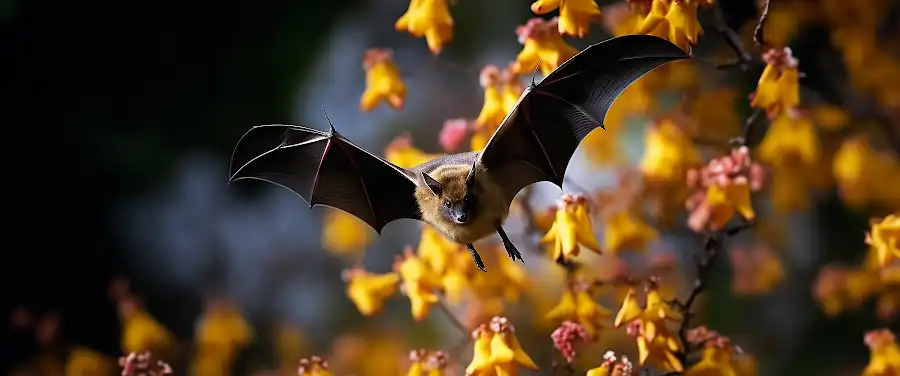
Often viewed adversely due to their eerie nocturnal habits, bats actually play a crucial role in maintaining the balance of ecosystems worldwide. However, in the realm of epidemiology, they’ve often been flagged as vectors of certain zoonotic diseases.
Bats as Disease Carriers
In plain language, zoonotic diseases are illnesses that animals can transmit to humans. Among diverse hosts, bats harbor some of the most deadly zoonotic pathogens. Their unique biological features enable them to host these diseases without getting sick.
Specific Diseases Linked to Bats
Rabies, Ebola, SARS, and even the notorious COVID-19, are a few examples of bat-borne diseases. These diseases traverse species boundaries, making bats substantial public health threats. Research reveals that bats constitute about 20% of the mammalian diversity and are associated with nearly 60–70% of emerging zoonotic diseases. According to the Centers for Disease Control and Prevention, at least 60% of all human pathogens and approximately 75% of new or emerging infectious diseases are zoonotic in nature.
Dissecting Viral Persistence in Bats
Viruses enduring within a host organism without causing disease is known as viral persistence. Bats, notably, don’t just carry viruses; they harbor them persistently while remaining seemingly unharmed.
One reason why bats host so many viruses without getting sick lies in their unique immune response. In contrast to other mammals, bats can regulate their immune systems to control viral proliferation effectively. This ability to co-adapt to pathogens, along with their long lifespans, flight capability, and social structure, make bats ideal for viral persistence.
Through understanding the relationship between bats and diseases, we can better comprehend how these creatures coexist with such deadly pathogens. It also allows us to develop more effective approaches to prevent the spillover of these diseases into humans.
As we delve further into understanding bats, let us explore the nature of bat-human interactions and the potential risks involved in the next section, “Understanding Bat-Human Interactions and Risks”.
Understanding Bat-Human Interactions and Risks
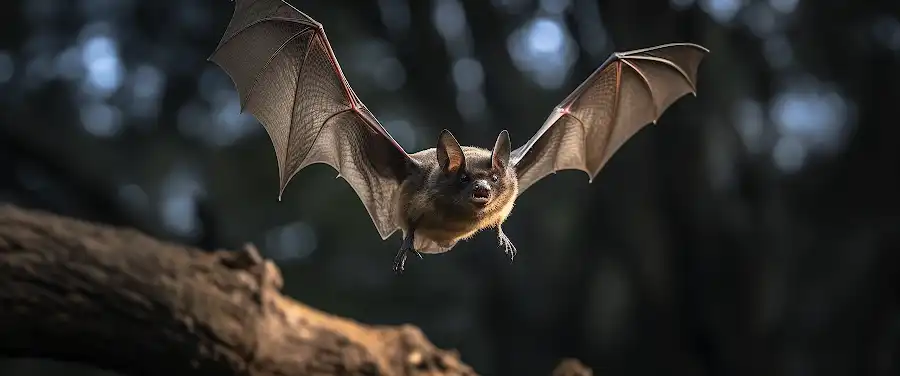
Bats are among nature’s most fascinating creatures. However, despite their unique capabilities and crucial role, they are often misunderstood and unfairly vilified as dangerous. It’s time we polish our Understanding Bats perspective and shed light on how their interaction with humans can be managed safely.
Encounters Between Humans and Bats
In a waning twilight or a quiet attic, encounters between humans and bats are more prevalent than you might think. These encounters can take many forms, from a bat inadvertently fluttering into your home, to close interactions in places where bats dwell.
However, crossing paths with bats isn’t always a harmless affair. Some species may carry the rabies virus, which can be transmitted to humans through bites or scratches. Bat bites, while rare, can pose significant health risks.
The following table illustrates some common situations where humans and bats are most likely to cross paths:
| Situation | Risk Level | Possible Encounter |
|---|---|---|
| Exploring caves | High | Bats habitats |
| Fruit harvesting | Medium | Attracted by ripe fruits |
| Attics or barns | Low | Roosting sites |
It’s not about avoiding these places, but about understanding and managing the potential risks sensibly.
Importance of Education and Responsible Behavior
Most issues connected to bat-human interactions can be attributed to misinformation or fear, which underscores the importance of bat education. A responsible approach toward these creatures can go a long way in diminishing potential dangers.
Here are some tips to help you handle bat encounters responsibly:
- Never touch a bat with bare hands. Use thick gloves if necessary.
- Keep a respectful distance from roosting sites.
- If a bat enters your home, calmly guide it towards the exit.
By following these guidelines, you can enjoy and appreciate these remarkable creatures from a safe distance, reducing occurrences of human-animal conflict, and protecting both the bats and us.
Let’s not forget that bats play an ecological role by controlling pests and pollinating plants. Thus, understanding bats effectively can pave the path for conservation of bat populations, which we’ll discuss next.
Conservation of Bat Populations
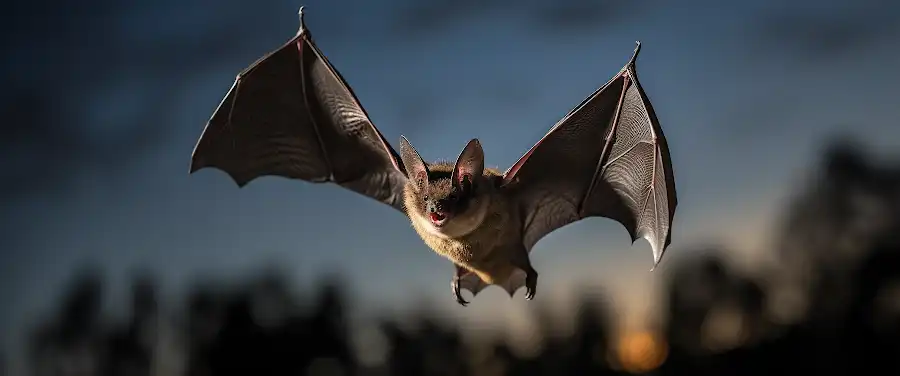
In our journey of understanding bats, it’s crucial to shed light on bat conservation, which has become a matter of paramount concern. Diverse threats have recently impacted these nocturnal mammals, causing disruption to bat species and the ecosystems they inhabit.
Threats Facing Bats
Bats face several challenges, with the primary threats being habitat loss, changing climate patterns, and disease. Habitats essential to bat survival have dramatically diminished, with human activities like deforestation and urbanization at the root. Climate change effects represent another major challenge, disrupting the delicate balance in their ecosystem and affecting food availability. Finally, diseases such as White Nose Syndrome have decimated certain bat populations.
This trifecta of threats has grave repercussions—not only for the bats but also for our environment. Bats play a vital role as pollinators, pest controllers, and seed dispersers. Their decline could indirectly generate adverse consequences for human survival.
Conservation Efforts and Their Importance
To combat these threats, various bat conservation efforts are underway across the globe. Organizations like Bat Conservation International carry out initiatives focused on bat protection and preservation. They employ conservation strategies such as habitat recovery, disease research, and public education.
Protecting and conserving bat species is not just an ecological imperative but a survival one.Bats account for a fifth of mammal species, and the loss of even a single species could upset the ecological balance.
Understanding bats and their importance is our first step in this conservation journey. The significance of these winged creatures is undeniable, making each attempt at their conservation worth the effort.
Conclusion
Understanding bats may have seemed like a whimsical journey into the realm of wildlife, but it’s so much more than that. These creatures, often painted as ghastly night flyers, carry crucial implications for our ecosystem and our health. In this journey, we discovered the incongruity between their viral persistence and their long lifespan. We’ve also seen how such understanding can aid measures to protect both bats and humans.
Isn’t it fascinating how these seemingly inconsequential creatures play such a vital role in our world? Remember, the very health of our ecosystems rests in part on their tiny wings. And, their unique properties hold the potential for unlocking scientific mysteries that could revolutionize human health.
That’s why it’s necessary to step out of the confines of fear and common misconceptions. Instead, we must embrace these creatures for what they truly are: a spectacular display of nature’s diversity, secrecy, and persistence.
Let’s cultivate a newfound respect for bats and their unique characteristics. Let’s continue to delve into their mysteries, for it is through this understanding that we’ll find harmony with them.
With that said, let’s also become a voice for their protection and conservation. We’ve seen the results of our oblivion and negligence towards nature. Now is the time to turn the tide, to make amends, and to work towards a future decked in conservationist awareness.
To sum it all up, understanding bats isn’t limited to wildlife enthusiasts or scientists. It’s for every single one of us. Because, at the end of the day, understanding these creatures brings us one step closer to understanding, respecting, and preserving the delicate balance of our world. It’s your turn now. Take the leap, dive into the intriguing world of bats, and play your part in their protection.
Frequently Asked Questions about Understanding Bats
Table of Contents
- The Anatomy of Bats: Adaptations for Flight and Echolocation
- Bats and the Ecosystem: Ecological Roles
- Social and Behavioral Aspects of Bats
- Bats and Diseases: Unraveling the Relationship
- Understanding Bat-Human Interactions and Risks
- Conservation of Bat Populations
- Conclusion
- Frequently Asked Questions about Understanding Bats




